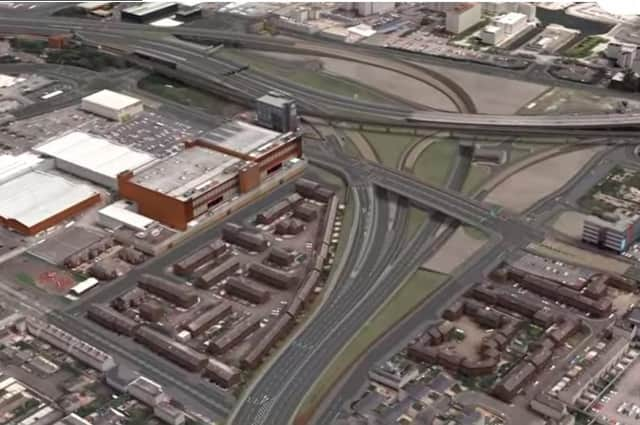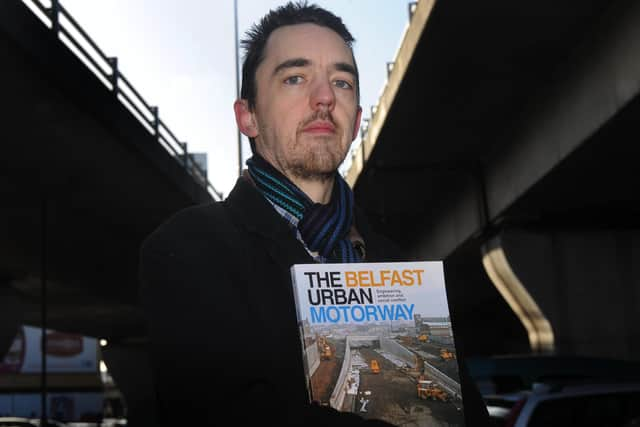Roads expert: I fear York St flyover junction in Belfast will never now be built


It isn’t a major blow for the project, but it is yet another in a long line of obstacles that have been placed in its way.
York Street interchange is the point where the busiest road in the province, the M2, meets the second busiest, the M3 and the third busiest, Westlink at a mess of traffic lights on the urban streets of north Belfast. The proposal is to eliminate the traffic lights and connect the three routes together with a series of underpasses and bridges. And all for an estimated £130m. But nothing has happened. What’s going on?
Advertisement
Hide AdAdvertisement
Hide AdThe scheme was first proposed in 2006 as the Westlink upgrade got underway. Roads Service, as it then was, admitted at the time that the advantages of the Westlink would not be fully realised until the traffic lights at York Street were removed. Roads Service enthusiastically progressed the scheme, which was clearly a high priority within the department.


It passed a public inquiry held in 2015 and some advanced site works even took place in 2016.
The assembly election of 2016 was the first spanner in the works. The new infrastructure minister was Sinn Féin’s Chris Hazzard, and Sinn Féin had made no secret of their desire to secure funding for roads in the West of the province, especially the A5, to correct what they called “the infrastructure deficit west of the Bann”.
Mr Hazzard went on to say that he was “looking at how funding could be increased to expedite delivery of the A5 scheme”, which effectively meant delaying schemes like York Street.
Advertisement
Hide AdAdvertisement
Hide AdThe executive ended up agreeing that the A5 and A6, but not York Street, would be their flagship projects. York Street got no funding. It theoretically qualified for 40% EU funding, but this was never applied for and Brexit ended those hopes, though exactly what went on behind the scenes remains muddy.
The 2017 general election saw the DUP enter a pact with the Conservatives, through which the DUP secured funding for the construction of York Street Interchange, a scheme they have always supported. However, this all proved to be moot when the Department of Infrastructure (DFI) attempted to appoint a contractor to build the scheme in early 2017.
At this point one of the losing bidders (BAM/ McCann) launched a legal challenge to the procurement process, alleging that it had been flawed, a case that they subsequently won in August 2018. The contract award was set aside by the courts in November 2018.
For some reason DFI decided to appeal the court ruling, wasting another year before losing the appeal anyway, in September 2019. By this time the DUP-Tory pact was hanging by a thread, and became irrelevant after the December 2019 general election, at which point the promised funding disappeared too.
Advertisement
Hide AdAdvertisement
Hide AdWhile the A6 projects progressed well during these years, the A5 was bogged down in intractable legal disputes, leaving little appetite to divert funding back to Belfast from the West. Stormont, meanwhile, had collapsed due to the RHI scandal leaving no ministers to make decisions anyway.
In January 2020 the assembly was restored and the new infrastructure minister was the SDLP’s Nichola Mallon. Ms Mallon was lukewarm about York Street Interchange from the outset, even omitting it entirely from the list of schemes she regarded as a priority in a press release in June.
Simultaneously, there were indications of a shift in thinking both at the community level and at a political level. Heathrow Airport had just lost an important court ruling (later overturned), Covid was making people think again about travel, and the climate emergency was encouraging people to ask if a motorway junction a mile from the city centre was really what Belfast needed.
At the same time, if sympathetically designed, the scheme has the potential to bring great benefits to the area by taking all strategic traffic off the local streets and down below ground level, leaving more space for redevelopment, restoring a sense of place to the surface streets and giving space for alternative forms of transport.
Advertisement
Hide AdAdvertisement
Hide AdIt is a rare example of a scheme that could be a win-win for all concerned.
Ms Mallon remains ambivalent about the scheme and has repeatedly spoken of the need to see the location of the project as a “place” and the need to ensure that the scheme did not lead to further severance and vehicle-dominance in this area. In July 2020 she ordered a “short, sharp review” of the project.
The review was completed in April 2021, and made recommendations, most notably to think more broadly about its impacts and to be more sympathetic to the local area. Further work is apparently now taking place on this but the minister has so far refused to give any further details.
My fear is that York Street Interchange will not now happen, at least not in the form envisaged five years ago. The 2017 legal challenge effectively killed the project because too much changed in the time it took to go through that process.
Advertisement
Hide AdAdvertisement
Hide AdIf the scheme does happen, it will be more modest in scale with a much greater focus on re-integrating this part of the North Belfast into the fabric of the city, with the need for free-flowing traffic being less of a defining factor in the design and a greater emphasis on other forms of transport. DFI engineers continue to see the scheme as a high priority, but they are under the direction of a minister who has a dual focus of further investment in the West and a greater degree of sympathy for sustainable transport than we have seen in any minister to date.
Things have definitely changed.
• Wesley Johnston is a roads commentator and author of ‘The Belfast Urban Motorway’
• Other comment pieces below, and beneath that information on how to subscribe to the News Letter
• Dr Esmond Birnie Nov 18: Northern Ireland is suffering a triple inflationary blow
Advertisement
Hide AdAdvertisement
Hide Ad• Dr Paul Kingsley Nov 17: Rise in exports from Northern Ireland to the Republic not as big as claimed
• Ruth Dudley Edwards Nov 16: The SDLP should return to moral clarity of Austin Currie
• Henry McDonald Nov 15: NHS workers should be required to have Covid vaccines
• Ben Lowry Nov 13: Essays in 2010 about NI on its 2021 centenary foresaw province staying in UK but not change from within
Advertisement
Hide AdAdvertisement
Hide Ad• Owen Polley Nov 13: Woke theories on history, gender and race get ‘stormy applause’
• Peter Robinson Nov 12: Opinion polls matter, if questions are well-defined
• Patrick Roche Nov 11: Archbishop’s comments a moral indictment of unionism
• Esmond Birnie Nov 10: Increasing interest rate now could lessen pain down the line
Advertisement
Hide AdAdvertisement
Hide Ad• Kenny Donaldson Nov 9: Amnesty admission makes mockery of Irish legacy criticism of Britain
• Writers Oct 30: We probe Irish nationalist myths in our new book which defends the Union
——— ———
A message from the Editor:
Thank you for reading this story on our website. While I have your attention, I also have an important request to make of you.
With the coronavirus lockdowns having had a major impact on many of our advertisers — and consequently the revenue we receive — we are more reliant than ever on you taking out a digital subscription.
Advertisement
Hide AdAdvertisement
Hide AdSubscribe to newsletter.co.uk and enjoy unlimited access to the best Northern Ireland and UK news and information online and on our app. With a digital subscription, you can read more than 5 articles, see fewer ads, enjoy faster load times, and get access to exclusive newsletters and content.
Visit
now to sign up.
Our journalism costs money and we rely on advertising, print and digital revenues to help to support them. By supporting us, we are able to support you in providing trusted, fact-checked content for this website.
Ben Lowry, Editor